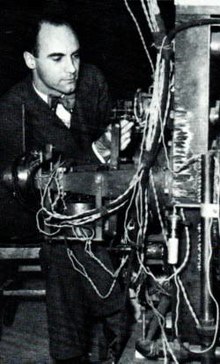Carl David Anderson

Carl David Anderson (3 September 1905 – 11 January 1991) was a U.S. experimental physicist. He is best known for his discovery of the positron, an achievement for which he received a Nobel Prize in 1936.
Anderson was born in New York City, the son of Swedish immigrants. He studied physics and engineering at Caltech (B.S., 1927; Ph.D., 1930). Under the supervision of Robert A. Millikan, he began investigations into cosmic rays during the course of which he encountered unexpected particle tracks in his cloud chamber photographs that he correctly interpreted as having been created by a particle with the same mass as the electron, but with opposite electrical charge. This discovery, announced in 1932 and later confirmed by others, validated Paul Dirac's theoretical prediction of the existence of the positron. Anderson obtained the first direct proof that positrons existed by shooting gamma rays produced by thorium carbide (ThC'') into other materials, resulting in creation of positron-electron pairs. For this work, Anderson shared the Nobel Prize in Physics for 1936 with Victor Hess.
Also in 1936, Anderson and his first graduate student, Seth Neddermeyer, discovered the muon (or 'mu-meson', as it was known for many years), a subatomic particle 207 times more massive than the electron. Anderson and Neddermeyer at first believed that they had seen the pion, a particle which Hideki Yukawa had postulated in his theory of the strong interaction. When it became clear that what Anderson had seen was not the pion, theoretical physicist I. I. Rabi, puzzled as to how the unexpected discovery could fit into any logical scheme of particle physics, famously asked "Who ordered that?" (sometimes the story goes that he was dining with colleagues at a Chinese restaurant at the time). The muon was the first of a long list of subatomic particles whose discovery initially baffled theoreticians who could not make the confusing 'zoo' fit into some tidy conceptual scheme. Willis Lamb claimed that he had heard it said at one point that "the finder of a new elementary particle used to be rewarded by a Nobel Prize, but such a discovery now ought to be punished by a $10,000 fine."
Carl Anderson spent all of his career at Caltech. During World War II he conducted research in rocketry. He died on 11 January, 1991, and is interred in the Forest Lawn, Hollywood Hills Cemetery in Los Angeles, California.
Selected papers
- C.D. Anderson, "The Positive Electron", Phys. Rev. 43, 491 (1933)
Sources
- American National Biography, vol. 1, pp. 445-446.
